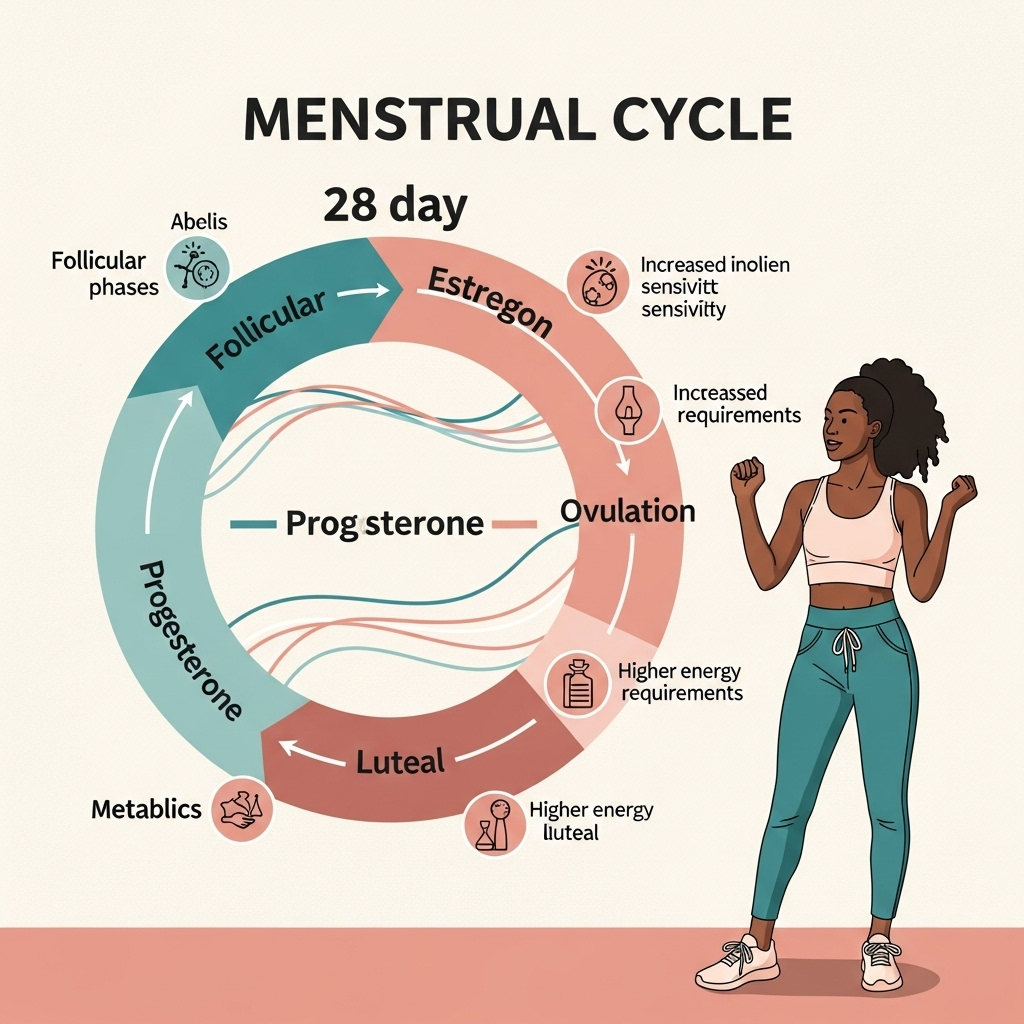For many years, we've approached nutrition with a "one-size-fits-all" mindset, as if our bodies' needs remain static day after day. But the reality, particularly for women and others who menstruate, is far more nuanced. Your body experiences significant hormonal fluctuations throughout your cycle that directly impact metabolism, insulin sensitivity, energy requirements, and even food preferences. Understanding and working with these natural rhythms rather than against them could be a game-changer for your metabolic health, energy levels, and overall wellbeing.
The Hormonal Dance and Its Metabolic Impact
The average menstrual cycle spans approximately 28 days and consists of distinct phases, each characterized by different hormonal profiles that significantly affect metabolism:
Follicular Phase (Days 1-14):
- Estrogen gradually rises while progesterone remains low
- Insulin sensitivity tends to be higher during this phase
- Energy expenditure is relatively lower
- Appetite is often more regulated
Ovulation (Around Day 14):
- Estrogen peaks, followed by a slight drop
- Testosterone briefly surges
- Insulin sensitivity remains relatively high
Luteal Phase (Days 15-28):
- Progesterone dominates, while estrogen follows a smaller second peak
- Insulin sensitivity decreases by 15-40% in many women
- Basal metabolic rate increases by up to 100-300 calories
- Appetite and cravings often intensify, particularly for carbohydrates and calorie-dense foods

These hormonal shifts create a fluctuating metabolic landscape that affects how your body processes nutrients. During times of higher insulin sensitivity (typically follicular phase), your body more efficiently clears glucose from the bloodstream. Conversely, when insulin sensitivity decreases (luteal phase), the same carbohydrate intake can produce higher blood glucose excursions.
This isn't just theoretical—many women with diabetes (particularly Type 1) report needing to adjust their insulin dosing throughout their cycle to maintain stable blood glucose levels, requiring more insulin during the luteal phase when insulin resistance naturally increases.
Strategic Nutrition Across Your Cycle
Rather than fighting against these natural variations, we can leverage them to optimize metabolic health:
Follicular Phase Nutrition
During this phase of enhanced insulin sensitivity, your body generally handles carbohydrates more effectively:
- Carbohydrate timing: This is an optimal time to include more complex carbohydrates in your diet, particularly around workouts when your muscles can utilize glucose effectively
- Meal composition: Aim for balanced meals with moderate carbohydrates from whole food sources (vegetables, fruits, legumes, whole grains if tolerated)
- Fasting consideration: If you practice time-restricted eating, many women find it easier and more beneficial during this phase
Example meal: A post-workout meal containing 4-6oz of protein, 1-2 cups of roasted sweet potatoes, and a large serving of non-starchy vegetables with olive oil would be well-tolerated during this phase.
Ovulation Phase Nutrition
Around ovulation, estrogen peaks before dropping, while testosterone briefly rises:
- Protein focus: Emphasize adequate protein intake (at least 30g per meal) to support muscle protein synthesis, which may be enhanced during this brief testosterone surge
- Energy levels: Many women experience peak energy levels around ovulation, making it an excellent time for higher-intensity workouts supported by appropriate nutrition
Example meal: A large salad with 5-6oz of salmon, avocado, diverse vegetables, and a small portion of quinoa provides balanced nutrition during this transitional phase.

Luteal Phase Nutrition
As progesterone rises and insulin sensitivity naturally decreases:
- Blood sugar regulation: Focus on balanced meals containing protein, healthy fats, and fiber to moderate glucose responses
- Increased energy needs: Honor your body's increased caloric demands (100-300 calories higher) to prevent excessive hunger
- Carbohydrate quality: Choose lower glycemic carbohydrates paired with protein, fat, and fiber to minimize blood sugar spikes
- Meal timing: More frequent, balanced meals may help maintain stable energy and blood sugar levels
- Cravings management: Prepare satisfying, nutrient-dense options that address cravings while supporting metabolic health
Example meal: A protein-centered meal with 5-6oz of grass-fed beef, roasted vegetables with plenty of fiber, half an avocado, and a small portion of lentils provides satiety while moderating glucose response.
Beyond Macros: Supporting Metabolic Health Throughout Your Cycle
While macronutrient adjustments form the foundation of cycle-synced nutrition, several additional factors deserve attention:
Micronutrient Considerations
Certain nutrients become particularly important during specific cycle phases:
- Magnesium: Often depleted during the luteal phase, magnesium can help with sleep disturbances, muscle cramps, and mood fluctuations
- B vitamins: Support energy production and neurotransmitter synthesis, which becomes crucial during the energy-demanding luteal phase
- Iron: Essential to replenish during menstruation, especially for those with heavier flows
- Zinc: Supports immune function and hormone production throughout the cycle
Hydration and Electrolyte Balance
Hormonal fluctuations affect fluid retention and electrolyte balance:
- Estrogen tends to promote fluid retention
- Progesterone has a mild diuretic effect
- During the luteal-to-menstrual transition, many experience water weight fluctuations
Maintaining consistent hydration with appropriate electrolytes can help minimize these fluctuations and support metabolic processes.
Sleep and Stress Management
Both sleep disruption and chronic stress can amplify metabolic challenges throughout your cycle:
- Progesterone can affect sleep quality during the luteal phase
- Sleep deprivation reduces insulin sensitivity
- Stress hormones like cortisol can counteract insulin, further complicating blood sugar management
Prioritizing sleep hygiene and incorporating stress management practices becomes particularly important during the more metabolically challenging luteal phase.
Practical Implementation for Metabolic Health
Tailoring your nutrition to your hormonal cycle doesn't require complex protocols. Start with these practical steps:
-
Track your cycle: Use an app or journal to identify your phases and correlate them with energy levels, hunger, and blood glucose patterns (if you measure)
-
Monitor your body's signals: Pay attention to hunger cues, energy fluctuations, and food preferences throughout your cycle
-
Adjust gradually: Begin by making small adjustments to carbohydrate amounts and meal timing during different phases
-
Maintain consistency in foundations: Regardless of cycle phase, prioritize protein (1g per pound of lean body mass daily), fiber-rich vegetables, and quality fats
-
Consider glucose monitoring: If available, using a continuous glucose monitor for even a short period can provide valuable insights into how your blood sugar responds to different foods throughout your cycle
-
Be flexible and compassionate: Your body's needs may vary from the typical pattern; honor your individual experience
For those with diabetes or insulin resistance, these cyclical adjustments may be even more significant. Working with healthcare providers to adjust medication dosing throughout your cycle can lead to more stable glucose levels and potentially reduce the frustration of unexplained glucose fluctuations.
By working with your body's natural rhythms rather than imposing a static nutritional approach, you can support metabolic health, energy levels, and overall wellbeing throughout your hormonal cycle. This approach acknowledges the dynamic nature of female physiology and turns what is often viewed as an inconvenience into an opportunity for optimized health.
References:
-
Yeung, E., Zhang, C., Mumford, S. L., Ye, A., Trevisan, M., Chen, L., Browne, R. W., Wactawski-Wende, J., & Schisterman, E. F. (2016). Longitudinal Study of Insulin Resistance and Sex Hormones over the Menstrual Cycle: The BioCycle Study. The Journal of Clinical Endocrinology & Metabolism, 101(12), 4896-4904.
-
Toth, M. J., Sites, C. K., Matthews, D. E., & Casson, P. R. (2006). Effect of menopausal status on energy expenditure and protein metabolism at rest and during moderate-intensity exercise. American Journal of Physiology. Endocrinology and Metabolism, 291(5), E1006-1012.






